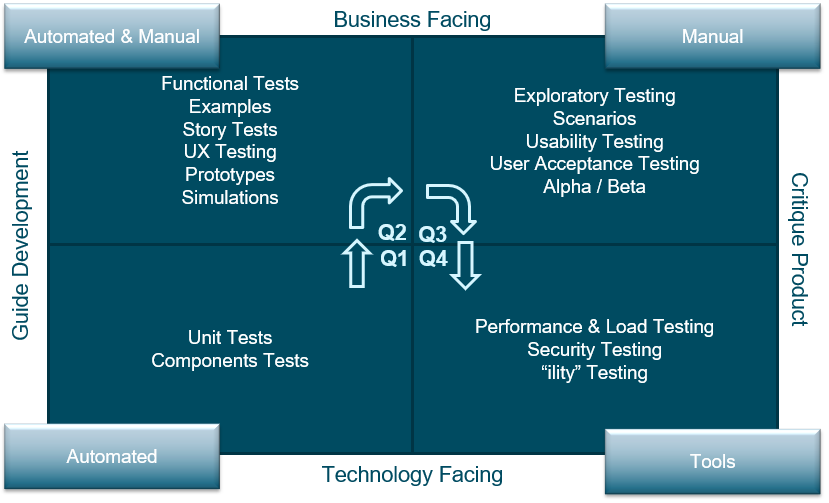En av grundpelarna i den agila testningen är att hela teamet ansvarar för kvalitén och utvecklare skall vara med och testa.
I ett team där bilden av test är att slumpvis knappa på ett tangentbord kan det vara svårt att förklara för de som inte jobbar med test att det innebär så mycket mer. Det går att sätta testningen eller snarare de olika aktiviteterna inom kvalitetsarbetet i ett perspektiv som de flesta förstår genom att använda den agila testkvadranten.
Denna introducerades av Brian Marick 2003 genom en tämligen enkel modell av en kvadrat uppdelad i fyra kvadrater där de två undre speglar tekniksidan och de två övre affärssidan. De två vänstra stödjer utveckling medan de två högra ifrågasätter produkten. Med tiden har modellen utvecklats för att bli ett ännu större stöd när man vill förklara och modellera agil testning. I sina böcker Agile Testing och More Agile Testing har Lisa Crispin och Janet Gregory lagt till element och exempel som gör det lättare att förstå och fördela aktiviteter i modellen.

- Q1 beskriver aktiviter som verifierar det tekniska systemet
- Q2 beskriver aktiviteter som verifierar hela systemet och affärsprocesser
- Q3 beskriver aktiviteter som verifierar kvaliten. Här hittar vi många av de aktiviteter som de flesta förknippar med test.
- Q4 beskriver aktiviteter som verifierar tekniska aspekter som oftast kräver att systemet är komplett
Genom att använda den här modellen kan man ofta skapa en större förståelse för var och varför man gör olika kvalitetsaktiviteter. Genom att lägga till en definition som Kristian Karl som är Test & Development Manager på Spotify presenterat kan man göra det ännu lite tydligare:
- Den vänstra sidan har ett preventivt syfte i.e. kontrollera det förväntade.
- Den högra sidan fokuserar på att hitta fel och defekter i.e. leta efter det oväntade.
Jag har använt de agila testkvadranterna på olika uppdrag där jag behövt få hela teamet att förstå hur man kan påbörja arbetet med kvalitet tidigare i processen, inte minst i team där det inte funnits någon testare. Bilden ovan är från ett sådant uppdrag där vi gemensamt i teamet mappade ut de olika aktiviterna innan vi började jobba fram detaljerna med hjälp av andra modeller.

